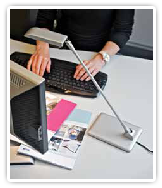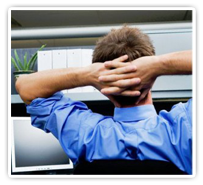When it comes to working as comfortably and efficiently as possible, don’t overlook the role of lighting and glare. As more and more workers, employers and HR personnel become aware of the importance of ergonomically-correct chairs, desks and keyboards, it’s vital to remember that the job’s only half done.
Improper lighting can cause eye strain and headaches, but did you know that it can contribute to strain on the neck, shoulders and back that often results from sitting incorrectly in order to see better or to avoid glare from improper lighting.
Too Much Light Or Not Enough?
 Low lighting vision accommodations such as leaning forward in the chair, bending the neck downward to view documents, and extending the head forward to see the monitor are common. These awkward working postures reverse the natural curvature of the head and neck, push the spine out of alignment and add significant stress to the neck and shoulders.
Low lighting vision accommodations such as leaning forward in the chair, bending the neck downward to view documents, and extending the head forward to see the monitor are common. These awkward working postures reverse the natural curvature of the head and neck, push the spine out of alignment and add significant stress to the neck and shoulders.
In contrast, high luminance environments may cause direct glare and excessive light contributing to eye strain, headaches and other visual discomforts. Older offices and facilities were designed before employees used computers extensively. The lighting was designed around working with paper documents not computers, and the belief that more is better. Fluorescent light fixtures lined the ceilings in nice even rows most likely providing more light than needed and little or no flexibility for the user.
 Good lighting has many benefits:
Good lighting has many benefits:
- It enhances your well-being
- It improves performance and efficiency
- It creates a positive work environment
- It adapts to your specific needs
- It is ergonomically correct
- It reduces the risk of headaches and tiredness
Proper Lighting Considerations
Determining the proper lighting for an area must take several factors into consideration including the nature of the work, the work environments, daytime or nighttime lighting needs and glare or reflections from both inside and outside. Other factors must be considered to determine the correct amount of lighting for an individual. Adjustments may need to be made based on the age of the worker, the task being performed and the size of the work area.
The eye changes with time, and by the time most people reach their forties, they will likely notice deterioration in eyesight. In addition to glasses, they may require more light to be able to carry out the same tasks. The need for light increases dramatically as we age. A person in his/her forties requires double the amount of light as a 20 year old.The high contrast between light and dark areas of the computer screen, your desktop or horizontal work surface, and the surrounding areas can cause eye fatigue and headaches.
In order to address the needs of a varying employee base and the variety of tasks performed, individual adjustable lighting should be considered. Different people want and need different levels of lighting. For optimal productivity, providing individual lighting allows each person to control the light levels in their own workstation to best meet their needs.
Remember the 20/20/20 Rule
 In addition to the correct lighting, vision related musculoskeletal discomforts can be relieved by regular Ergo Breaks. When taking these breaks, it also is a good idea to stand up and stretch to relieve muscle tension in your neck, back and shoulders. Remember to allow a break for the eyes too. Look up and away often when performing prolonged near vision tasks. For computer users, a helpful tip is to remember the "20-20-20 rule” - every 20 minutes, look away from your computer screen and direct your gaze at an object that is at least 20 feet away for at least 20 seconds. This relaxes the focusing muscle inside the eye reducing the risk of eyestrain and eye fatigue. It also relaxes eye alignment muscles used to converge your eyes for near work
In addition to the correct lighting, vision related musculoskeletal discomforts can be relieved by regular Ergo Breaks. When taking these breaks, it also is a good idea to stand up and stretch to relieve muscle tension in your neck, back and shoulders. Remember to allow a break for the eyes too. Look up and away often when performing prolonged near vision tasks. For computer users, a helpful tip is to remember the "20-20-20 rule” - every 20 minutes, look away from your computer screen and direct your gaze at an object that is at least 20 feet away for at least 20 seconds. This relaxes the focusing muscle inside the eye reducing the risk of eyestrain and eye fatigue. It also relaxes eye alignment muscles used to converge your eyes for near work
Correct lighting simply helps users work better and be more productive. In addition, light influences people. The right lighting can have significant influences on you and your employees.
Lighting and glare rank right up there with posture and ergonomically-correct chairs, desks and keyboards when it comes to preventing eye and neck strain, but they can be addressed with some forethought and common sense. The right lighting solutions help create the experience of comfortable, flexible and stimulating working environments.






 Low lighting vision accommodations such as leaning forward in the chair, bending the neck downward to view documents, and exte...
Low lighting vision accommodations such as leaning forward in the chair, bending the neck downward to view documents, and exte... Good lighting has many benefits:
Good lighting has many benefits: In addition to the correct lighting, vision related musculoskeletal discomforts can be relieved by regular Ergo Breaks. When taking these breaks, it also is a good idea to stand up and stretch to relieve muscle tension in your neck, back and shoulders. Remember to allow a break for the eyes too. Look up and away often when performing prolonged near vision tasks. For computer users, a helpful tip is to remember the "20-20-20 rule” - every 20 minutes, look away from your computer screen and direct your gaze at an object that is at least 20 feet away for at least 20 seconds. This relaxes the focusing muscle inside the eye reducing the risk of eyestrain and eye fatigue. It also relaxes eye alignment muscles used to converge your eyes for near work
In addition to the correct lighting, vision related musculoskeletal discomforts can be relieved by regular Ergo Breaks. When taking these breaks, it also is a good idea to stand up and stretch to relieve muscle tension in your neck, back and shoulders. Remember to allow a break for the eyes too. Look up and away often when performing prolonged near vision tasks. For computer users, a helpful tip is to remember the "20-20-20 rule” - every 20 minutes, look away from your computer screen and direct your gaze at an object that is at least 20 feet away for at least 20 seconds. This relaxes the focusing muscle inside the eye reducing the risk of eyestrain and eye fatigue. It also relaxes eye alignment muscles used to converge your eyes for near work Follow these tips when you are using an iPad or tablet to prevent neck and eye strain:
Follow these tips when you are using an iPad or tablet to prevent neck and eye strain: Payments securely processed by:
Payments securely processed by: 